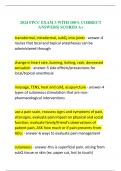2024 FPCC EXAM 3 WITH 100% CORRECT
ANSWERS| SCORED A+
transdermal, intradermal, subQ, into joints - answer-4
routes that local and topical anesthesias can be
administered through
change in heart rate, burning, itching, rash, decreased
sensation - answer-5 side effects/precautions for
local/topical anesthesia
massage, TENS, heat and cold, acupuncture - answer-4
types of cutaneous stimulation that are non-
pharmacological interventions
use a pain scale, reassess signs and symptoms of pain,
vital signs, evaluate pain impact on physical and social
function, evaluate family/friend's observations of
patient pain, ASK how much or if pain prevents from
ADLs - answer-6 ways to evaluate pain management
cutaneous - answer-this is superficial pain, arising from
subQ tissue or skin (ex. paper cut, hot to touch)
,visceral - answer-this pain is caused by the stimulation
of deep, internal pain receptors. Can be described as a
tight pressure or cramping (ex. menstrual cramps,
bowel disorders, labor pain, organ cancer)
deep somatic - answer-this pain originates in ligaments,
tendons, nerves, blood vessels, and bones. Localized
and described as achy or tender. (ex. fracture, sprain,
arthritis, bone cancer)
psychogenic - answer-this pain is believed to originate
from the mind; patient perceives pain despite no
physical cause that can be identified.
visceral, somatic - answer-two types of nociceptive pain
are and .
neuropathic - answer-type of pain that is a complex
and often chronic pain that arises when injury to one or
more nerves results in repeated transmission of pain
signals even in the absence of stimuli.
,acute - answer-which type of pain is protective- acute
or chronic?
whenever you take full set of vitals (routinely) - answer-
when should pain be assessed on patient?
patient self report - answer-what is the most reliable
way to assess patient pain?
mild, moderate or severe - answer-nonpharmacological
interventions are good alternatives if experiencing
pain, but should be used as complementary
interventions if pain is or .
heat - answer- promotes circulation, which speeds
healing.
contralateral stimulation - answer-stimulating skin in
area opposite of the painful site
, localized, diffuse - answer-cutaneous stimulation is best
for pain that is and not
visual (watch TV), tactile (touch, stroking a pet),
intellectual (puzzle), auditory (music therapy) - answer-
4 types of distraction that can use to help distract from
pain
guided imagery - answer-uses auditory and imaginary
processes to affect emotions and help calm, divert, and
relax.
diaphragmatic - answer-what type of breathing
promotes relaxation
opioids - answer-kind of medication we should give if
patient is in severe pain
n/v, constipation, itching, breakouts - answer-4
common side effects seen with opioid use




